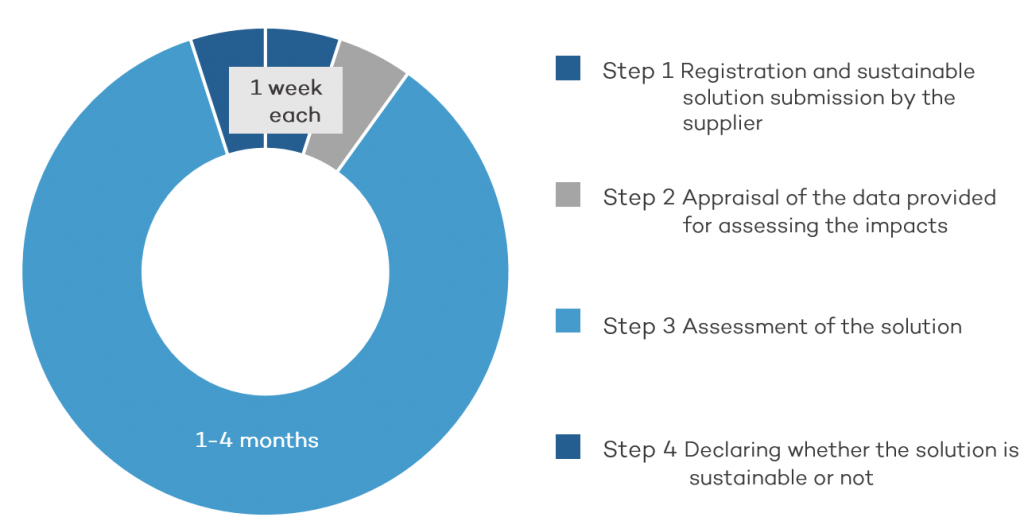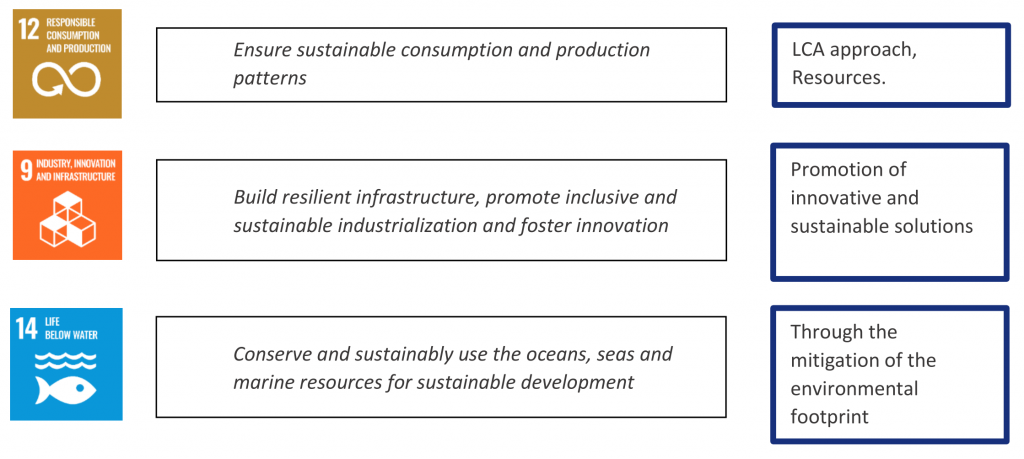What are the goals of the verification process?
The verification process aims to assess and verify the products and services that are claimed by their manufacturers to be sustainable. These solutions are expected to accelerate change within the industry and offer the best practices that are currently available on the market.
The present verification is aimed towards all the main stakeholders of the yachting industry (B2B), but also to the consumers (B2C) as well as public institutions (B2G) for collaboration to mitigate the impacts inside the Blue Economy sector, showing its commitment towards the achievement of the Sustainable Development Goals (SDGs).
What methodology is behind the process?
The verification process obtains a quantified evaluation of solutions’ impact on the environment as well as on human health. The development follows the same methodological framework used for Water Revolution Foundation’s Yacht Assessment Tool (YAT) with both YAT and the verification process basing the calculations of the impacts on life cycle assessment (LCA) methodology.
LCA is the most approved and spread scientific methodology for assessing the potential environmental impacts associated with a product or a service. One of the prime reasons behind the success is its holistic approach: understanding that we need to broaden the borders of the object of the environmental analysis through taking into consideration its entire life cycle. This enables quantifying the (potential) impact of the different stages of a product’s or service’s life cycle: raw material extraction, processing, manufacturing, distribution, use, repair & maintenance, and disposal or recycling.
This approach delivers complete information about the impacts caused by a product or service. Indeed, the United Nations and European Commission have acknowledged the efficiency and importance of the LCA methodology, and this has brought and will bring the inclusion of LCA in the legal framework of many countries in the near future.
How does the verification process work?
As it is LCA-based, the verification process begins with identifying the correct category to which the product or service belongs and, according to this category, delivering to the solution’s owner the corresponding data collection sheet (Step 1). The data collection sheet is a simple Excel file in which we request and guide you through collecting the right data needed. Collecting this data is a straightforward but labour-intensive process. Please be aware that you will need to dedicate enough time to complete this task so that we have the required data to work with.
Once this is complete and checked (Step 2), we can carry out the assessment (Step 3) by following ISO 14040-44 that standardises the LCA methodology as well as how to perform an LCA assessment. The results are reported in the personal account of the solution’s owner. Note that these results are not intended to be published.
 Graphic representation of the time taken to complete the verification process.
Graphic representation of the time taken to complete the verification process.
What is needed to be verified?
LCA results use a comparative analysis with a comparable Business as Usual (BAU) product or service. This is the starting point to determine whether the submitted solution indeed produces fewer impacts than the mainstream alternative product, based on quantitative measurement. Verification shall be granted if the results of the comparative analysis show a sufficient reduction on all ten environmental indicators studied. For this, the following scheme is followed:
 Diagram representing the calculation scheme and the process to verify the sustainability of a submitted product or service.
Diagram representing the calculation scheme and the process to verify the sustainability of a submitted product or service.
As shown in the diagram above, at least five of the nine highlighted parameters must present a reduction in terms of impacts caused along the life cycle of the submitted solution in order to meet the verification criteria. These parameters, in fact, reflect the two most important challenges of sustainability: climate change and loss of biodiversity.
The tenth environmental indicator, the Eco-point, is considered separate because it is an aggregated result consisting of three different categories of damage: human health, ecosystem quality, and resources. If the comparative analysis indicates a reduction in all three categories, the solution will be considered sustainable.
According to the methodology and the chosen environmental indicators for the assessment, we can confirm that the following Sustainable Development Goals are taken into account:

Participation fee
The verification process is a collaboration. Time and data are required from companies when submitting their sustainable solution for verification. However, the biggest investment of time is on the side of Water Revolution Foundation. Therefore, for the verification process we kindly request a participation fee of €2,500 per solution to cover a portion of our labour costs. Water Revolution Foundation wants to keep the barrier as low as possible and prefers that companies view the process as a collaborative relationship. For partners of the foundation, this verification process is free of cost. Find out more about becoming a Water Revolution Foundation partner.
In order to encourage companies to submit their solutions, a reduced participation fee is offered to the first 20 companies who submit previously-verified solutions. A previously-verified solution is one that has been assessed by a research institution, university or expert and was found to have a quantifiable improvement compared to the category standard offering. Such a solution may already have a verification label or documentation that proves the results of the assessment. Note that all assessments, whether previously assessed or not, will still go through Water Revolution Foundation’s verification process.
The reduced participation fee is capped at one per company, so companies submitting multiple solutions are only eligible for one discount. Companies that submit their solutions first are eligible for a greater discount, with the 20 reduced participation fees allocated as follows:
- First five companies (1-5) will receive a 40% discount;
- Next five companies (6-10) will receive a 30% discount;
- Next five companies (11-15) will receive a 20% discount;
- Next five companies (16-20) will receive a 10% discount.
Why you should submit your solutions for verification
Having a verified sustainable solution will not only result in the commercial benefits of being included in, and, as such, promoted through, our database of sustainable solutions to key decision makers in the superyacht industry. There is much more to it.
The value of the process
The verification process itself has significant value. If your solution was to be assessed by a specialised agency or institution, the costs could easily add up to tens of thousands of euros. Here is why: in order to benchmark your solution against the ‘business as usual’, a large amount of data needs to be collected and assessed, before even being able to start assessing yours. This pre-work is ongoing by Water Revolution Foundation, and is part of our Yacht Assessment Tool developments. These investments have been and are being made by the foundation for the greater interest of the industry, as it allows Water Revolution Foundation to assess all kinds of solutions, ultimately to significantly reduce the environmental impact of superyachts. Regardless of the outcome of the verification process, the feedback report provides companies with valuable insights about their solution.
The verification stamp
Being able to prove to your stakeholders that your solution has been verified by an independent and science-driven foundation, with stringent methodological framework, showcases reliability and confirms your solution’s ability to reduce environmental impact. To demonstrate this, we created the Water Revolution Foundation verification stamp. This can be used on your own website or promotional material, to showcase its effectiveness in reducing environmental impact.
Subsequently, your solution will be included in our Yacht Assessment Tool. This tool is based on computational sustainability, a cutting edge sustainability approach and decision support system, and your solution will be showcased during the decision-making process when it comes to designing and building a new yacht or refitting an existing yacht when reviewing alternative, more sustainable solutions.
Additional benefits
But that is not all. Water Revolution Foundation believes that those who invest in a sustainable future deserve to be rewarded. Therefore, the foundation is actively developing incentives and benefits with organisations to increase the number of benefits for suppliers of sustainable solutions. Expect to hear more about this in 2021.
Go to the registration page to start the verification process together.[/vc_column_text][/vc_column][/vc_row]


